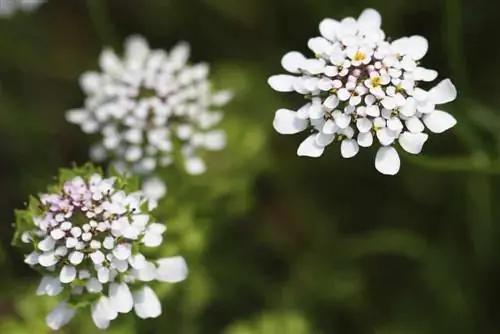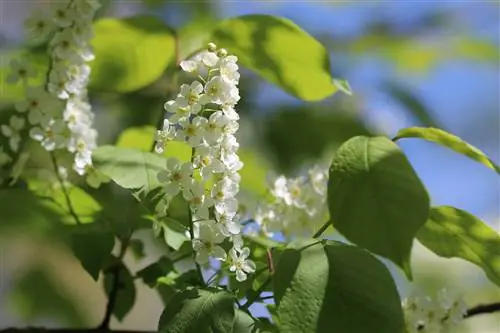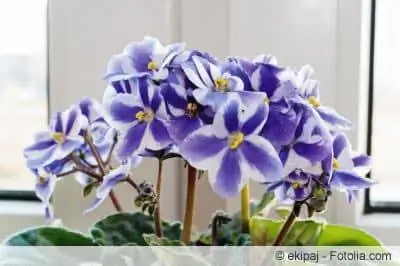- Author admin [email protected].
- Public 2023-12-17 03:39.
- Last modified 2025-01-24 12:45.
The candytuft can be used in a variety of ways in the garden. It adorns a rock garden as well as larger floor areas. And yes, with its flowers in white, pink, red or purple, it sets attractive visual accents. The perennial plant is very undemanding and does not require much care. It is even hardy up to a certain point and can withstand bitter frosty nights.
Location
The candytuft, whose botanical name is Iberis, originally comes from the sun-drenched Mediterranean region. This is almost certainly the reason why it prefers a location that is as sunny as possible. The blazing midday sun is not a problem for the plant. On the contrary: she really enjoys being illuminated so directly. The location should also be as open as possible. There is no need for a sheltered location from the wind. Since Iberis prefers to grow on stony or rocky terrain in its country of origin, it can be ideally cultivated in a rock garden. But it also copes perfectly with steep embankments and other slopes. If necessary, it also grows in partial shade, although it doesn't grow quite as beautifully in such a location.
Tip:
If the location is semi-shady, the candytuft needs to be watered properly, especially in spring. This ensures that the flowers grow nice and large, even though there is sometimes a lack of sun.
Floor

As already mentioned, candytuft is a really undemanding perennial plant. This also expressly applies to the demands it places on the soil or plant substrate. A nutrient-poor soil is therefore no problem for them at all. It will still grow and thrive. On the other hand, an excess of nutrients is of course also accepted by Iberis. However, the growth can become so lush that wild growths occur and the plant has to be brought back into shape. The soil or plant substrate should ideally meet the following requirements:
- rather dry soil
- very high water permeability
- very loose soil
- no high humus content
- more nutrient-poor than too nutrient-rich
Even if these requirements are not met, the candytuft will normally grow. It can cope with all conceivable soil conditions. However, it is essential that water can drain away easily and that the formation of waterlogging is not promoted.
Tip:
For soils with a lot of clay, sand should definitely be added and, if possible, drainage should be installed. The location for the soap flower may even need to be reconsidered.
Planting
Planting and transplanting the Iberis is completely unproblematic. It can be done in spring and summer. However, you should avoid planting in autumn or winter. To plant, simply dig up a plant that is approximately twice as large as the root ball. You then place the bale in the hole and immediately cover it with the previously dug soil. This is pressed well around the trunk. You should also water as heavily as possible. The plant can also be moved easily during the warm season. Since the candytuft is often cultivated as a pot plant, it is also possible to take it out of the plant pot in summer and plant it directly in the garden.
Note:
During all planting activities, it is essential to ensure that the very sensitive roots of the Iberis are not damaged.
Pouring
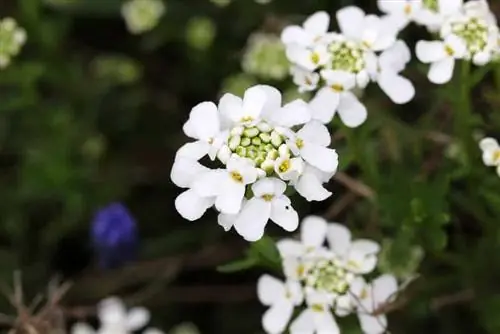
The candytuft comes from an area where long dry periods are almost a given. As a result, it can cope with drought without any major problems. What's more: she even appreciates dry phases. Of course, Iberis needs water and needs to be watered during the summer months, but this should only be done in moderation - and only when there is really no rainfall. When watering, the following should be noted:
- Keep a dry period of one to two weeks
- only give small amounts of water
- the soil in the root area should only be slightly moist immediately after watering
- Always water directly in the root area
- Avoid waterlogging at all costs
As already mentioned, watering in spring can cause candytufts placed in a partially shaded location to produce particularly large flowers. Otherwise, watering in spring is usually not necessary. Action should only be taken when the soil is very dry, even at a depth of around ten centimeters.
Fertilize
You should also act cautiously when it comes to applying fertilizer to the candytuft. However, it is not possible to do without fertilizer during the growth phase in summer. During this time, the plant needs a mineral-based fertilizer about twice. Ideally, you should use conventional liquid fertilizer from specialist retailers. It is then simply tipped into the irrigation water according to the manufacturer's instructions and then administered when watering. In addition, it doesn't hurt to apply a little lime to the root area of the candytuft in summer. It is also important that the perennial is fertilized again after pruning in the summer - assuming you want it to bloom a second time.
Cutting
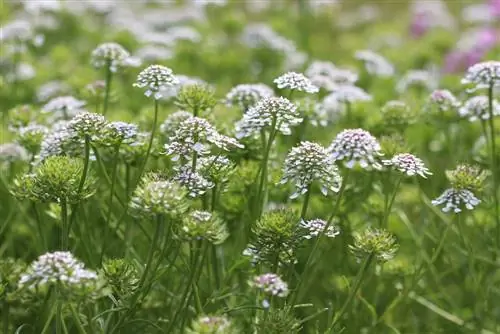
In order to really grow perfectly, the candytuft should be cut twice a year. The cut not only promotes growth, but also ensures an optimal visual impression. Without pruning, Iberis would grow relatively wild and thus lose much of its natural beauty. The first cut takes place in spring. Then only dried leaves and shoots are removed. The second cut is due after the flowering period. How to do it:
- Cut shoots back by half or a maximum of a third
- leave at least ten centimeters each
- always pay attention to the woodiness
The following applies:
The more woody the candytuft in question is, the less deeply it can be cut. Pruning after flowering can continue into autumn, but should definitely be done before the first night of frost. Smaller pruning measures, however, can be carried out throughout spring and summer. Dead or brown leaves should be removed consistently.
Wintering
The candytuft can handle temperatures of up to minus 15 degrees Celsius relatively easily. They can therefore be described as winter hardy. Therefore, special measures for overwintering the plant are usually not necessary. The Iberis can simply remain in its location. However, in regions where temperatures regularly fall below 15 degrees, it is advisable to protect the plant with brushwood or mulch. It is also possible to cover them with a fleece.
Diseases and pests
One of the many advantages of the candytuft is undoubtedly that it is extremely robust and resilient. Diseases or pest infestations are very rare. The only problem that can become problematic is an infestation with aphids. It is therefore advisable to check the leaves and stems of the plant regularly. If you notice an infestation of aphids, the perennial should be showered thoroughly and then coated with a low-dose detergent solution. Under certain circumstances it can also happen that the roots of the candytuft are attacked by a fungus. Unfortunately, as a garden owner you only notice this when the entire plant falls over. This is why it is also referred to as damping-off disease. Unfortunately there is no cure for this. Once the plant has been tipped over, the only thing left to do is dig it up and dispose of it in the trash can. Candytufts should then no longer be planted at the affected location.
Propagate
Propagate the candytuft is absolutely no problem. The plant is self-seeding. So it reproduces itself. The fruits that it produces in the summer contain seeds that are distributed after the fruit bursts open. This can be problematic as it can lead to uncontrollable growths. You should therefore cut off the fruits that are still closed, open them and dry the seeds they contain. It can then be checked until autumn and applied to the desired locations. Alternatively, propagation from cuttings is also possible in summer. To do this, simply cut off a shoot from the plant, put it in a glass of water and wait until it develops roots. As soon as this is the case it can then be planted.

